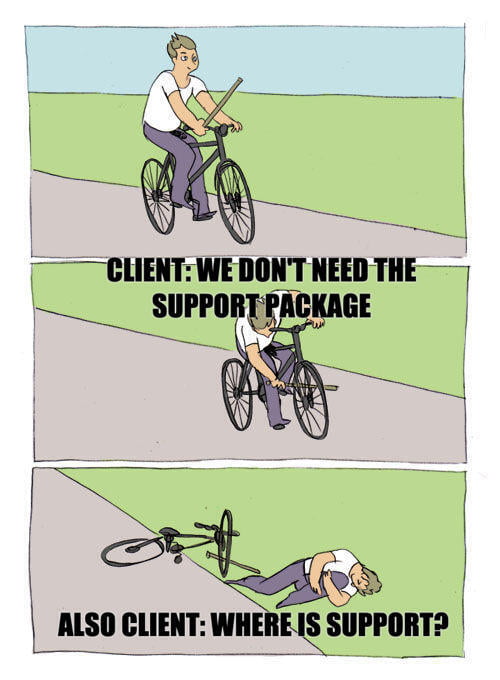Change is inevitable, but not always for the better
If you go say, skydiving and the instructor say you have about 75% to 95% chance of splatting to the ground and die, would you do it? If you are normal like I assume you are, or anybody with a right mind for that matter; would say no. Hell no.
Then, why do people line up to do digital changes in their companies? Because surprise, surprise, 75% - 95% is the range of rate of failure of such projects. Would you take the figurative dive into it?
Now, it's not a fair comparison, I know. Changes in our organization mean opportunities to improve efficiency, facilitate human capital growth, reduce cost in the long run, and hopefully, increase revenue. Skydiving's pay up is the immediate and fleeting rush of adrenaline at the moment, but in business, there's a huge upside to look forward to.
But still, the chance for you to fail is high. Which begs the question, why? Let's 'dive' right into it.

1. Nobody knows how to use it
This is the primary reason for digital transformation failure. And you can be certain, and even use this as a measuring stick that if there's nobody in your company who has enough skills in the technology or the process being introduced and used, the project will almost always fail in the end.
We've seen a lot of these cases ourselves. Staff whom we trained and supported to the bone to make the technology their bread and butter, left the company. And because the company had an improper handover process, the knowledge couldn't be transferred in a timely manner. Everything went out together with that employee.
The issue is not the employee leaving (although in part it is), but the issue lies when the company underestimates the need to have enough people who are skilful enough to use the technology and understand the process being implemented. With this mindset, they don't see the need to properly train the staff, take new ones to fill in the vacuum, and to do a periodical audit. The aftermath? Two possibilities;
- The company abandons the changes and technology; rendering all the investment, thus far wasteful, or;
- The company spends more on staff retraining while facing a long and painful downtime.
Both scenarios waste a lot of money, time, and effort. Wait, isn't that what we're trying to save by implementing the changes? Ironic, I know.
Employees should be provided with enough training and support. Not just one, but both. If they are not properly trained, then how can they be excited about the changes? The things that are supposedly there to help their job are now just another hindrance and add to their workload. They'll become resistant, for sure.
But some of them may take extra initiatives to find information and to ask around. Without a strong support system, even the best of them could wither and lose interest. Many companies underestimate the need to have continuous support from the vendor and more importantly from a select few within their organization. Failure to establish a sturdy support system is equivalent to having a weak foundation.

2. Changes are being forced down
There's a saying I stumbled upon not too long ago when I was reading a book, it goes,
"A change imposed, is a change opposed"
What a powerful quote that is, partly, because it rhymes.
But what it means is no less true. A change that is forced, mandated, and shoved down the throats of your employees will almost always be regurgitated in a a disgusting manner resulting in a pool of contemptuous vomit. Nobody likes the sight of it, everybody pinches down their nose from the sheer smell of it and worse, now other people are feeling queasy too. It's a matter of time that this would be a chain of mass vomiting across the organization.
Psychologically speaking, people want to feel like they have some say in something and they have a level of control over it. If you impose these changes without getting input and buy-ins from the very people who would be using the system day in and day out, beware, you're guaranteed a ticket to failure valley.
The simple solution to this is to include key users in the discussion to decide things. Keep them involved in every step of the way and provide them with clarity as to why this needs to be done and you need their input to make this a success. That notion alone will make people more willing to go through the change later on. Don't 'act' like you care, please, do actually care what they say.
3. It's too big, it's too sudden!
Have you ever stood up too fast and your world suddenly spins and you started to lose your bearings? Yes, it's like that. Although standing up to go do something else is a must, we know not to do it too quickly and to adjust our speed accordingly. It's the same with an organization. If you ask it to go through a drastic change both in size and speed, everybody would be in disarray and disorganized. Worse case scenario? The company will fall. You know what they say about a fall; the bigger you are, the harder the fall.
We've implemented solutions to a group of companies. We went to its subsidiaries and trained their staff all over the country. But what you might not know is, those companies are forced to take up these new applications almost immediately. The time given was not nearly enough for the whole organization to prepare themselves for a change of this magnitude. This primarily, among other factors, contributed to the inevitable collapse of the implemented solutions, resulting in literally, hundreds of thousands of bucks of losses.
The idea of change for the better is completely welcome and much needed in a sense, but execution matters. Let people be accustomed to a few things first, run a good campaign, implement the changes in stages, have a check every now and then to get a continuous feedback, and adjust accordingly.
4. Poor communication
Taking the group of companies as an example again, we can see that this is also a major contributor to the failure of a change. Let me paint you a picture to demonstrate one aspect of a failed communication. When we went to a subsidiary in the north to train their staff, we were warmly welcomed and thus we started our role.
1 hour into the training, we noticed some yawns and some steam coming out of heads, as if they are just waiting to explode. So we stopped. We asked them, "are you guys fine so far? Anything you want to raise? " And this got to be the most surprising statement/question ever.
"We've only heard of this system an hour ago. What is it for?"

I can almost see the look on your face, because that's how we looked when they ask the question.
This shows that the changes were not properly communicated to the end users; the very people who would be using the system daily. Not even what are the changes that are going to be implemented, let alone the reasons behind it and how it would impact the people's day to day work. The first time they hear about it, is from the vendor, and during the training session, no less.
It's common sense, really. You have to tell everybody what will be changing. Why are you changing it? How is this going to affect everybody? What can they do to prepare themselves? How can you help to prepare them? What are the benefits that they can get out of the changes? Assure people that their jobs will stay relevant and secure. A proper planning, particularly in communicating these changes will go a long way. For your sake, talk, people!
5. It doesn't stick
To be precise, the organization fails to sustain the change and champion it all the way after the initial stages. True, there are things to be done before the implementation, i.e. Planning it, communicating it, and scheduling it. And then, doing the implementation itself, which involves an exhaustive list of things to do.
I remember this one particular client. We implemented a highly customized and automated system for them. A lot of manual and analogue work from the old ways were transformed to the digital format and thus rendered the conventional methods redundant, supposedly. I personally remember this case vividly because I was the one who did all the works; from planning, implementing, training, and documenting. So I am personally invested, hoping with every fibre of my being, that the system will be used and things would be easier for everybody.
Sadly, even after 2 years of subscribing to the system, it was not used properly and thus the full potential of our (my) solution could not be harvested. The reason? There's not enough push from the management to sustain the change. Every time somebody complains, the management caved in and allowed them to fall back to the old ways. When somebody came and try to understand the system, the management was not supportive enough to give a timely action in forms of retraining or even giving sufficient information.
The management also did not monitor the effectiveness and failed to measure any goals. Without an end to the means, then to where are we supposed to go? Give us a shiny ship with all the latest gizmos to sail in but give us no map, we're just another pathetic vessel in the unforgiving ebb and flow of the ocean.
Wrapping Up
In the end, as an organization, it is progress for the better that we want for our company. Nobody in their right mind would want their company to fail after spending so much money, time, and effort. Our experience so far has taught us a very valuable lesson; a lesson that you might be able to read and listen to anywhere. But experiencing it is another thing. It really hits us different and we hope it will give you a better realization as well.
To help you invoke some good thoughts before you go into this change process, we have prepared a free Change Readiness Assessment tool that you and your employee can take. The answers to the questions will give you an overview of the individual's readiness and your company's readiness as well. Don't make the same mistakes, we sincerely hope you won't.

As always, good luck.


